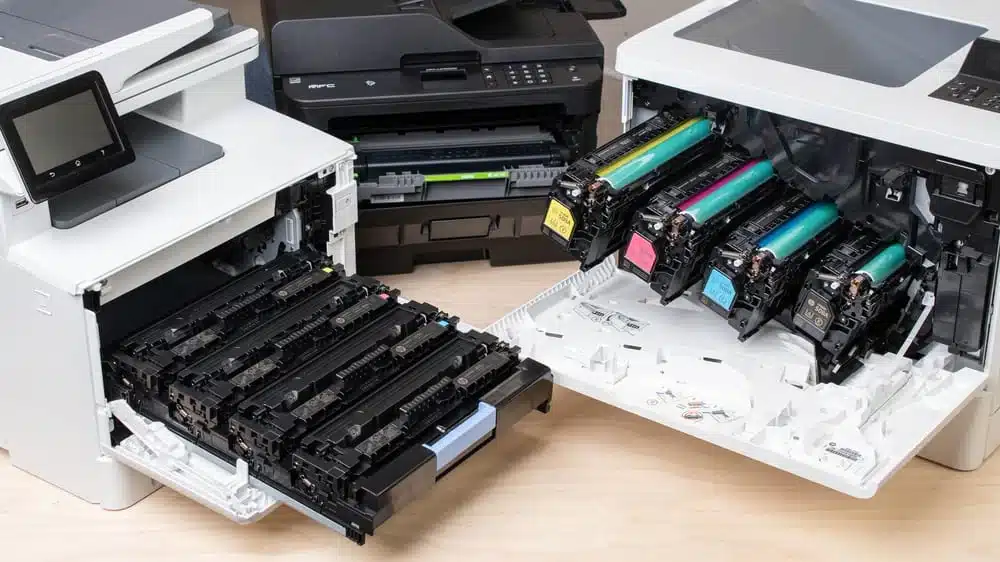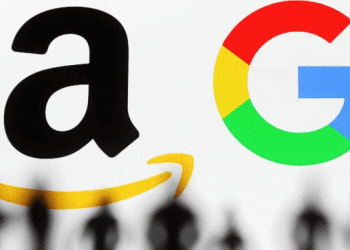When it comes to choosing a printer for your home or office, you're faced with a crucial decision: inkjet or laser printer.
Both types of printers have their strengths and limitations, and the right choice depends on your specific needs and budget.
In this comprehensive guide, we'll explore the key differences between inkjet and laser printers, helping you make an informed decision that offers the best value for your printing needs.
Understanding Inkjet Printers
[caption id="attachment_11034" align="aligncenter" width="500"]

Epson Colour Inkjet Printer | Credit: IndiaMART | Source: Google[/caption]
Inkjet printers are a popular choice for home users and small businesses due to their versatility and affordability.
They work by spraying tiny droplets of ink onto paper to create text and images. Here are some key characteristics and advantages of inkjet printers:
1. High-Quality Color Printing
Inkjet printers excel in producing high-quality colour prints, making them ideal for tasks like photo printing, graphic design, and marketing materials. They can accurately reproduce vibrant colours and intricate details, delivering impressive results.
2. Affordable Initial Cost
Compared to laser printers, inkjet printers generally have a lower upfront cost. This affordability makes them accessible to a wide range of users, including students and individuals with basic printing needs.
3. Compact and Lightweight
Inkjet printers are often compact and lightweight, making them suitable for small spaces and easy to move around when needed.
4. Quiet Operation
Most inkjet printers operate quietly, which can be an important factor if you're working in a shared office or a quiet home environment.
5. Versatility
Inkjet printers can handle various paper types, including glossy photo paper, labels, and speciality media. This versatility allows you to print a wide range of documents and projects.
Limitations of Inkjet Printers
[caption id="attachment_11033" align="aligncenter" width="2560"]

Canon PIXMA InkJet Printer | Credit: Best Buy | Source: Google[/caption]
While inkjet printers offer several advantages, they also come with some limitations to consider:
Slower Printing Speed: Inkjet printers are generally slower than laser printers, which may not be suitable for high-volume printing tasks.
Ink Cartridge Costs: The cost of inkjet printer ink cartridges can add up over time, particularly if you print frequently. Some users find that the cost of replacement ink cartridges can be a drawback.
Print Head Maintenance: Inkjet printers require regular maintenance to keep the print heads clean and prevent clogs, which can affect print quality.
Text Printing Quality: While inkjet printers produce excellent colour prints, their text printing quality may not be as sharp as that of laser printers, making them less suitable for text-heavy documents.
Understanding Laser Printers
[caption id="attachment_11031" align="aligncenter" width="1024"]

HP Laser Printer | Credit: The New York Times | Source: Google[/caption]
Laser printers are known for their speed and efficiency, making them a popular choice for busy offices and environments with high-volume printing demands. These printers use a different technology than inkjets, involving a toner cartridge and a laser beam. Here are some key characteristics and advantages of laser printers:
1. Fast Printing Speed
Laser printers are significantly faster than inkjet printers, making them ideal for large print jobs and office environments. They can churn out pages at a rapid pace, saving you time.
2. Cost-Effective Printing
While laser printers may have a higher upfront cost, they often offer a lower cost per page when compared to inkjet
printers. This cost-effectiveness becomes evident when you're printing in bulk.
3. Crisp Text Printing
Laser printers are renowned for their sharp and precise text printing, making them the preferred choice for text-heavy documents like reports, contracts, and business correspondence.
4. Minimal Maintenance
Compared to inkjet printers, laser printers require less maintenance. They have fewer moving parts and don't have printheads that need regular cleaning, reducing downtime.
5. High-Volume Printing
Laser printers are designed for high-volume printing tasks and can handle large paper trays, allowing you to print hundreds of pages without frequent paper replenishment.
Limitations of Laser Printers
[caption id="attachment_11028" align="aligncenter" width="1000"]

Laser Printers Inks | Credit: ProductNation | Source: Google[/caption]
While laser printers are a solid choice for many, they also have some limitations:
Higher Initial Cost: Laser printers typically come with a higher initial price tag than inkjet printers, which may not be budget-friendly for some users.
Limited Color Printing: While laser printers can produce colour prints, they are not as proficient at high-quality colour reproduction as inkjet printers.
Bulkiness: Laser printers are often larger and heavier than inkjet printers, making them less suitable for small spaces or mobility.
Warm-Up Time: Laser printers may require a short warm-up time before they can start printing, which can be inconvenient if you need quick, on-demand printing.
Choosing the Right Printer for You
[caption id="attachment_11037" align="aligncenter" width="572"]

How to Choose Between Inkjet and Laser Printer | Credit: 123ink.ie[/caption]
Now that you understand the key differences between
inkjet and laser printers, how do you choose the right one for your needs? Here are some factors to consider:
1. Printing Requirements
Evaluate your typical printing needs. Do you primarily print text documents, or do you require high-quality colour prints for graphics or photos? Laser printers excel at text, while inkjets are better for colour and image printing.
2. Volume of Printing
Consider the volume of printing you do. If you have high-volume printing needs, a laser printer's speed and cost-effectiveness may outweigh its initial cost. For occasional printing, an inkjet printer may suffice.
3. Budget
Your budget plays a significant role in your choice. While laser printers may have a higher upfront cost, consider the long-term cost of consumables like ink or toner cartridges.
4. Available Space
Think about the available space in your home or office. Inkjet printers are typically smaller and more suitable for tight spaces, while laser printers may require more room.
5. Text vs. Graphics
If your printing is text-heavy, prioritize a laser printer for crisp text quality. For graphic-heavy or photo printing, an inkjet printer is a better fit.
6. Speed Requirements
If you need fast printing for time-sensitive documents, a laser printer's speed advantage may be essential.
7. Maintenance Preferences
Consider your willingness to perform printer maintenance. Inkjet printers require more maintenance due to their printheads, while laser printers need less frequent attention.
Frequently Asked Questions (FAQs) about inkjet and laser printers
[caption id="attachment_11042" align="aligncenter" width="1120"]

FAQ About Laser and Inkjet Printers | Credit: PC Mag[/caption]
FAQ 1: What is the primary difference between an inkjet and a laser printer?
Answer: The primary difference lies in the technology they use. Inkjet printers spray tiny droplets of ink onto paper, while laser printers use toner and a laser beam to create images and text.
FAQ 2: Which type of printer is better for printing high-quality photos?
Answer: Inkjet printers are generally better for high-quality photo printing due to their ability to reproduce vibrant colours and fine details.
FAQ 3: Are laser printers faster than inkjet printers?
Answer: Yes, laser printers are typically faster than inkjet printers, making them suitable for high-volume printing tasks.
FAQ 4: Do laser printers require more maintenance than inkjet printers?
Answer: No, laser printers require less maintenance than inkjet printers since they don't have printheads that need cleaning.
FAQ 5: Which type of printer is more cost-effective for printing in large volumes?
Answer: Laser printers are generally more cost-effective for large-volume printing due to their lower cost per page.
FAQ 6: Can I print colour documents with a laser printer?
Answer: Yes, laser printers can print colour documents, but their colour reproduction may not be as high-quality as that of inkjet printers.
FAQ 7: Do inkjet printers perform well for text-heavy documents?
Answer: Inkjet printers are better suited for colour and image printing. Laser printers excel at printing crisp text for text-heavy documents.
FAQ 8: Are inkjet printers suitable for occasional home use?
Answer: Yes, inkjet printers are often a good choice for occasional home use due to their affordability and versatility.
FAQ 9: Do laser printers take up more space than inkjet printers?
Answer: Yes, laser printers are usually larger and bulkier than inkjet printers, which can be a consideration if you have limited space.
FAQ 10: Which type of printer is more budget-friendly in the long run?
Answer: The long-term budget depends on your printing volume. For high-volume printing, a laser printer's lower cost per page may be more budget-friendly, while inkjet printers may be cost-effective for occasional use.
Conclusion
When deciding which to choose between inkjet and laser printers, there's no one-size-fits-all answer. The right choice depends on your unique printing needs and preferences.
Evaluate your requirements for quality, speed, volume, and budget to determine whether an inkjet or laser printer offers better value for you.
Both types of printers have their strengths, so understanding your priorities will lead you to the perfect printing solution.
 Epson Colour Inkjet Printer | Credit: IndiaMART | Source: Google[/caption]
Inkjet printers are a popular choice for home users and small businesses due to their versatility and affordability.
They work by spraying tiny droplets of ink onto paper to create text and images. Here are some key characteristics and advantages of inkjet printers:
Epson Colour Inkjet Printer | Credit: IndiaMART | Source: Google[/caption]
Inkjet printers are a popular choice for home users and small businesses due to their versatility and affordability.
They work by spraying tiny droplets of ink onto paper to create text and images. Here are some key characteristics and advantages of inkjet printers:
 Canon PIXMA InkJet Printer | Credit: Best Buy | Source: Google[/caption]
While inkjet printers offer several advantages, they also come with some limitations to consider:
Slower Printing Speed: Inkjet printers are generally slower than laser printers, which may not be suitable for high-volume printing tasks.
Ink Cartridge Costs: The cost of inkjet printer ink cartridges can add up over time, particularly if you print frequently. Some users find that the cost of replacement ink cartridges can be a drawback.
Print Head Maintenance: Inkjet printers require regular maintenance to keep the print heads clean and prevent clogs, which can affect print quality.
Text Printing Quality: While inkjet printers produce excellent colour prints, their text printing quality may not be as sharp as that of laser printers, making them less suitable for text-heavy documents.
Canon PIXMA InkJet Printer | Credit: Best Buy | Source: Google[/caption]
While inkjet printers offer several advantages, they also come with some limitations to consider:
Slower Printing Speed: Inkjet printers are generally slower than laser printers, which may not be suitable for high-volume printing tasks.
Ink Cartridge Costs: The cost of inkjet printer ink cartridges can add up over time, particularly if you print frequently. Some users find that the cost of replacement ink cartridges can be a drawback.
Print Head Maintenance: Inkjet printers require regular maintenance to keep the print heads clean and prevent clogs, which can affect print quality.
Text Printing Quality: While inkjet printers produce excellent colour prints, their text printing quality may not be as sharp as that of laser printers, making them less suitable for text-heavy documents.
 HP Laser Printer | Credit: The New York Times | Source: Google[/caption]
Laser printers are known for their speed and efficiency, making them a popular choice for busy offices and environments with high-volume printing demands. These printers use a different technology than inkjets, involving a toner cartridge and a laser beam. Here are some key characteristics and advantages of laser printers:
HP Laser Printer | Credit: The New York Times | Source: Google[/caption]
Laser printers are known for their speed and efficiency, making them a popular choice for busy offices and environments with high-volume printing demands. These printers use a different technology than inkjets, involving a toner cartridge and a laser beam. Here are some key characteristics and advantages of laser printers:
 Laser Printers Inks | Credit: ProductNation | Source: Google[/caption]
While laser printers are a solid choice for many, they also have some limitations:
Higher Initial Cost: Laser printers typically come with a higher initial price tag than inkjet printers, which may not be budget-friendly for some users.
Limited Color Printing: While laser printers can produce colour prints, they are not as proficient at high-quality colour reproduction as inkjet printers.
Bulkiness: Laser printers are often larger and heavier than inkjet printers, making them less suitable for small spaces or mobility.
Warm-Up Time: Laser printers may require a short warm-up time before they can start printing, which can be inconvenient if you need quick, on-demand printing.
Laser Printers Inks | Credit: ProductNation | Source: Google[/caption]
While laser printers are a solid choice for many, they also have some limitations:
Higher Initial Cost: Laser printers typically come with a higher initial price tag than inkjet printers, which may not be budget-friendly for some users.
Limited Color Printing: While laser printers can produce colour prints, they are not as proficient at high-quality colour reproduction as inkjet printers.
Bulkiness: Laser printers are often larger and heavier than inkjet printers, making them less suitable for small spaces or mobility.
Warm-Up Time: Laser printers may require a short warm-up time before they can start printing, which can be inconvenient if you need quick, on-demand printing.
 How to Choose Between Inkjet and Laser Printer | Credit: 123ink.ie[/caption]
Now that you understand the key differences between inkjet and laser printers, how do you choose the right one for your needs? Here are some factors to consider:
How to Choose Between Inkjet and Laser Printer | Credit: 123ink.ie[/caption]
Now that you understand the key differences between inkjet and laser printers, how do you choose the right one for your needs? Here are some factors to consider:
 FAQ About Laser and Inkjet Printers | Credit: PC Mag[/caption]
FAQ 1: What is the primary difference between an inkjet and a laser printer?
Answer: The primary difference lies in the technology they use. Inkjet printers spray tiny droplets of ink onto paper, while laser printers use toner and a laser beam to create images and text.
FAQ 2: Which type of printer is better for printing high-quality photos?
Answer: Inkjet printers are generally better for high-quality photo printing due to their ability to reproduce vibrant colours and fine details.
FAQ 3: Are laser printers faster than inkjet printers?
Answer: Yes, laser printers are typically faster than inkjet printers, making them suitable for high-volume printing tasks.
FAQ 4: Do laser printers require more maintenance than inkjet printers?
Answer: No, laser printers require less maintenance than inkjet printers since they don't have printheads that need cleaning.
FAQ 5: Which type of printer is more cost-effective for printing in large volumes?
Answer: Laser printers are generally more cost-effective for large-volume printing due to their lower cost per page.
FAQ 6: Can I print colour documents with a laser printer?
Answer: Yes, laser printers can print colour documents, but their colour reproduction may not be as high-quality as that of inkjet printers.
FAQ 7: Do inkjet printers perform well for text-heavy documents?
Answer: Inkjet printers are better suited for colour and image printing. Laser printers excel at printing crisp text for text-heavy documents.
FAQ 8: Are inkjet printers suitable for occasional home use?
Answer: Yes, inkjet printers are often a good choice for occasional home use due to their affordability and versatility.
FAQ 9: Do laser printers take up more space than inkjet printers?
Answer: Yes, laser printers are usually larger and bulkier than inkjet printers, which can be a consideration if you have limited space.
FAQ 10: Which type of printer is more budget-friendly in the long run?
Answer: The long-term budget depends on your printing volume. For high-volume printing, a laser printer's lower cost per page may be more budget-friendly, while inkjet printers may be cost-effective for occasional use.
FAQ About Laser and Inkjet Printers | Credit: PC Mag[/caption]
FAQ 1: What is the primary difference between an inkjet and a laser printer?
Answer: The primary difference lies in the technology they use. Inkjet printers spray tiny droplets of ink onto paper, while laser printers use toner and a laser beam to create images and text.
FAQ 2: Which type of printer is better for printing high-quality photos?
Answer: Inkjet printers are generally better for high-quality photo printing due to their ability to reproduce vibrant colours and fine details.
FAQ 3: Are laser printers faster than inkjet printers?
Answer: Yes, laser printers are typically faster than inkjet printers, making them suitable for high-volume printing tasks.
FAQ 4: Do laser printers require more maintenance than inkjet printers?
Answer: No, laser printers require less maintenance than inkjet printers since they don't have printheads that need cleaning.
FAQ 5: Which type of printer is more cost-effective for printing in large volumes?
Answer: Laser printers are generally more cost-effective for large-volume printing due to their lower cost per page.
FAQ 6: Can I print colour documents with a laser printer?
Answer: Yes, laser printers can print colour documents, but their colour reproduction may not be as high-quality as that of inkjet printers.
FAQ 7: Do inkjet printers perform well for text-heavy documents?
Answer: Inkjet printers are better suited for colour and image printing. Laser printers excel at printing crisp text for text-heavy documents.
FAQ 8: Are inkjet printers suitable for occasional home use?
Answer: Yes, inkjet printers are often a good choice for occasional home use due to their affordability and versatility.
FAQ 9: Do laser printers take up more space than inkjet printers?
Answer: Yes, laser printers are usually larger and bulkier than inkjet printers, which can be a consideration if you have limited space.
FAQ 10: Which type of printer is more budget-friendly in the long run?
Answer: The long-term budget depends on your printing volume. For high-volume printing, a laser printer's lower cost per page may be more budget-friendly, while inkjet printers may be cost-effective for occasional use.




















